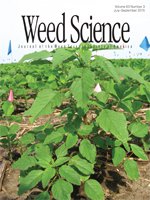Waterhemp is an increasingly problematic weed in the U.S. Midwest, having now evolved resistances to herbicides from six different site-of-action groups. Glyphosate-resistant waterhemp in the Midwest is especially concerning given the economic importance of glyphosate in corn and soybean production. Amplification of the target-site gene, 5-enolpyruvylshikimate-3-phosphate synthase (EPSPS) was found to be the mechanism of glyphosate resistance in Palmer amaranth, a species closely related to waterhemp. Here, the relationship between glyphosate resistance and EPSPS gene amplification in waterhemp was investigated. Glyphosate dose response studies were performed at field sites with glyphosate-resistant waterhemp in Illinois, Kansas, Kentucky, Missouri, and Nebraska, and relative EPSPS copy number of survivors was determined via quantitative real-time polymerase chain reaction (qPCR). Waterhemp control increased with increasing glyphosate rate at all locations, but no population was completely controlled even at the highest rate (3,360 g ae ha−1). EPSPS gene amplification was present in plants from four of five locations (Illinois, Kansas, Missouri, and Nebraska) and the proportion of plants with elevated copy number was generally higher in survivors from glyphosate-treated plots than in plants from the untreated control plots. Copy number magnitude varied by site, but an overall trend of increasing copy number with increasing rate was observed in populations with gene amplification, suggesting that waterhemp plants with more EPSPS copies are more resistant. Survivors from the Kentucky population did not have elevated EPSPS copy number. Instead, resistance in this population was attributed to the EPSPS Pro106Ser mutation. Results herein show a quantitative relationship between glyphosate resistance and EPSPS gene amplification in some waterhemp populations, while highlighting that other mechanisms also confer glyphosate resistance in waterhemp.
Nomenclature: Glyphosate; common waterhemp, Amaranthus tuberculatus (Moq.) Sauer var. rudis (Sauer) Costea and Tardif; Palmer amaranth, Amaranthus palmeri S. Wats AMAPA; corn, Zea mays L.; soybean, Glycine max (L.) Merr.





